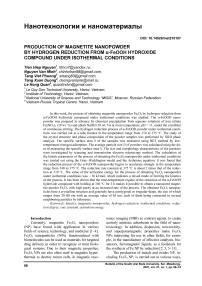By hydrogen reduction from a-FeOOH hydroxide compound under isothermal conditions
Автор: Tien Hiep Nguyen, Nguyen Van Minh, Tang Viet Phuong, Tang Xuan Duong, Le Hong Quan
Журнал: Вестник Южно-Уральского государственного университета. Серия: Металлургия @vestnik-susu-metallurgy
Рубрика: Нанотехнологии и наноматериалы
Статья в выпуске: 1 т.21, 2021 года.
Бесплатный доступ
In this work, the process of obtaining magnetite nanopowder Fe3O4 by hydrogen reduction from α-FeOOH hydroxide compound under isothermal conditions was studied. The α-FeOOH nanopowder was prepared in advance by chemical precipitation from aqueous solutions of iron nitrate Fe(NO3)3 (10 wt. %) and alkali NaOH (10 wt. %) at room temperature, pH = 11, under the condition of continuous stirring. The hydrogen reduction process of α-FeOOH powder under isothermal conditions was carried out in a tube furnace in the temperature range from 310 to 375 °С. The study of the crystal structure and phase composition of the powder samples was performed by XRD phase analysis. The specific surface area S of the samples was measured using BET method by low-temperature nitrogen adsorption. The average particle size D of powders was calculated using the data of measuring the specific surface area S. The size and morphology characteristics of the particles were investigated by scanning and transmission electron microscopy method. The calculation of the kinetic parameters of the process of obtaining the Fe3O4 nanopowder under isothermal conditions was carried out using the Gray-Weddington model and the Arrhenius equation. It was found that the reduction process of the α-FeOOH nanopowder begins to accelerate strongly in the temperature range from 340 to 375 °С. The reduction rate constant at 375 °С is about 2 times that of the reduction at 310 °С. The value of the activation energy for the process of obtaining Fe3O4 nanopowder under isothermal conditions was ~ 36 kJ/mol, which indicates a mixed mode of limiting the kinetics of the process. It has been shown that the time-temperature regime of the reduction of the α-FeOOH hydroxide compound with holding at 340 °С for 3 h makes it possible to obtain a nanosized magnetite powder Fe3O4 with high purity at an increased rate of the process. The obtained Fe3O4 nanoparticles have a crystalline structure and generally have a polygonal or irregular shape, the size of which ranges from 30-80 nm with an average value of 65 nm, each of them being connected to several neighboring particles by isthmuses.
Kinetics, magnetite nanopowder, hydrogen reduction, isothermal conditions, reduction degree, rate constant, activation energy
Короткий адрес: https://sciup.org/147233978
IDR: 147233978 | DOI: 10.14529/met210107
Список литературы By hydrogen reduction from a-FeOOH hydroxide compound under isothermal conditions
- Bhushan B. (Ed.). Springer Handbook of Nanotechnology. Heidelberg, 2017. 1500 p.
- Ortega G., Reguera E. Biomedical applications of magnetite nanoparticles. Chapter 13. In book: Materials for Biomedical Engineering. Nanomaterials-Based Drug Delivery. Elsevier, 2019, pp. 397–434. DOI: 10.1016/b978-0-12-816913- 3. Rudakovskaya P.G., Beloglazkina E.K., Mazhuga A.G., Klyachko N.L., Kabanov A.V., Zyk N.V. Synthesis of magnetite-gold nanoparticles with core-shell structure. Moscow University Chemistry Bulletin, 2015, vol. 56, no. 3, pp. 181–189. (in Russ.) DOI: 10.3103/S0027131415030104
- Dahman Y. Nanotechnology and Functional Materials for Engineers. Elsevier, Health Sciences Division, 2017. 282 p.
- Morel M., Martínez F., Mosquer E. Synthesis and characterization of magnetite nanoparticles from mineral magnetite. Journal of Magnetism and Magnetic Materials, 2013, vol. 343, pp. 76–81. DOI: 10.1016/j.jmmm.2013.04.075
- Pei W., Kumada H., Natusme T., Saito H., Ishio S. Study on magnetite nanoparticles synthesized by chemical method. Journal of Magnetism and Magnetic Materials, 2007, vol. 310, iss. 2, pp. 2375–2377. DOI: 10.1016/j.jmmm.2006.10.837
- Klekotka U., Satula D., Nordblad P., Kalska-Szostko B. Layered magnetite nanoparticles modification – synthesis, structure, and magnetic characterization. Arabian Journal of Chemistry, 2020, vol. 13, iss. 1, pp. 1323–1334. DOI: 10.1016/j.arabjc.2017.11.002
- Wei Y., Han B., Hu X., Lin Y., Wang X., Deng X. Synthesis of Fe3O4 Nanoparticles and their Magnetic Properties. Procedia Engineering, 2012, vol. 27, pp. 632–637. DOI: 10.1016/j.proeng.2011.12.498
- Wen X., Yang J., He B., Gu Z. Preparation of monodisperse magnetite nanoparticles under mild conditions. Current Applied Physics, 2008, vol. 8, iss. 5, pp. 535–541. DOI: 10.1016/j.cap.2007.09.003
- Martínez-Mera I., Espinosa-Pesqueira M.E., Pérez-Hernández R., Arenas-Alatorre J. Synthesis of magnetite (Fe3O4) nanoparticles without surfactants at room temperature. Materials Letters, 2007, vol. 61, iss. 23–24, pp. 4447–4451. DOI: 10.1016/j.matlet.2007.02.018
- Rashdan S., Selva Roselin L., Selvin R., Lemine O.M., Bououdina M. Nanoparticles for biomedical applications: Current status, trends and future challenges. In book: Biomaterials and Medical Tribology. Elsevier, Woodhead Publishing, 2013, pp. 1–132. DOI: 10.1533/9780857092205.1
- Wallyn J., Anton N., Vandamme T.F. Synthesis, Principles, and Properties of Magnetite Nanoparticles for In Vivo Imaging Applications-A Review. Pharmaceutics, 2019, vol. 11 (11), 601. DOI: 10.3390/pharmaceutics11110601
- Ryzhonkov D.I., Konyukhov Y.V., Nguyen V.M. Kinetic regularities and mechanisms of hydrogen reduction of nanosized oxide materials in thin layers. Nanotechnologies in Russia, 2017, vol. 12, no. 11–12, pp. 620–626. (in Russ.) DOI: 10.1134/s1995078017060076
- Kargin D.B., Mukhambetov D.G., Konyukhov Y.V., Altynov E.A., Aznabakiev K.R. Magnetic properties of iron and iron oxide nanopowders produced from rolling mill scale. XXII International conference about permanent magnets, 2019, p. 107.
- Filatov S.V., Zagainov S.A., Gileva L.Yu., Pykhteeva K.B. Development of the analysis of iron oxide reduction processes. Izvestiya. Ferrous Metallurgy, 2015, vol. 58, no. 9, pp. 658–661. (in Russ.) DOI: 10.17073/0368-0797-2015-9-658-661
- Berdnikov V.I., Gudim Yu.A. Chemical reactions at reduction of iron from oxides by natural gas. Izvestiya. Ferrous Metallurgy, 2020, vol. 63, no. 1, pp. 84–86. (in Russ.) DOI: 10.17073/0368-0797-2020-1-84-86
- Roshchin V.E., Roshchin A.V. General electron theory of reduction and oxidation of metals. Izvestiya. Ferrous Metallurgy, 2020, vol. 63, no. 3–4, pp. 271–285. (in Russ.) DOI: 10.17073/0368-0797-2020-3-4-271-285
- Konyukhov Yu.V. [Development of scientific and technology foundations for synthesizing nanopowders from industrial raw materials and materials modification using energy-mechanical treatment. Dissertation of Dr. Sci. (Tech.)]. Moscow, NUST “MISiS”, 2018. 303 p. (in Russ.)
- Kolpakova N.A., Romanenko S.V., Kolpakov V.A. [Collection of problems in chemical kinetics]. Tomsk, TPU Publ., 2008. 280 p. (in Russ.)
- Schmalzried H. Chemical kinetics of solids. Weinheim, VCH, 1995. 433 p.1.00013-1


